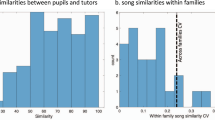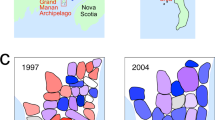Abstract
Culture is typically viewed as consisting of traits inherited epigenetically, through social learning. However, cultural diversity has species-typical constraints1, presumably of genetic origin. A celebrated, if contentious, example is whether a universal grammar constrains syntactic diversity in human languages2. Oscine songbirds exhibit song learning and provide biologically tractable models of culture: members of a species show individual variation in song3 and geographically separated groups have local song dialects4,5. Different species exhibit distinct song cultures6,7, suggestive of genetic constraints8,9. Without such constraints, innovations and copying errors should cause unbounded variation over multiple generations or geographical distance, contrary to observations9. Here we report an experiment designed to determine whether wild-type song culture might emerge over multiple generations in an isolated colony founded by isolates, and, if so, how this might happen and what type of social environment is required10. Zebra finch isolates, unexposed to singing males during development, produce song with characteristics that differ from the wild-type song found in laboratory11 or natural colonies. In tutoring lineages starting from isolate founders, we quantified alterations in song across tutoring generations in two social environments: tutor–pupil pairs in sound-isolated chambers and an isolated semi-natural colony. In both settings, juveniles imitated the isolate tutors but changed certain characteristics of the songs. These alterations accumulated over learning generations. Consequently, songs evolved towards the wild-type in three to four generations. Thus, species-typical song culture can appear de novo. Our study has parallels with language change and evolution12,13,14. In analogy to models in quantitative genetics15,16, we model song culture as a multigenerational phenotype partly encoded genetically in an isolate founding population, influenced by environmental variables and taking multiple generations to emerge.
This is a preview of subscription content, access via your institution
Access options
Subscribe to this journal
Receive 51 print issues and online access
$199.00 per year
only $3.90 per issue
Buy this article
- Purchase on Springer Link
- Instant access to full article PDF
Prices may be subject to local taxes which are calculated during checkout




Similar content being viewed by others
References
Marler, P. & Sherman, V. Innate differences in singing behavior of sparrows reared in isolation from adult conspecific song. Anim. Behav. 33, 57–71 (1985)
Chomsky, N. Aspects of the Theory of Syntax (MIT Press, 1965)
Catchpole, C. K. & Slater, P. B. J. Bird Song: Biological Themes and Variations (Cambridge Univ. Press, 2008)
Marler, P. & Tamura, M. Culturally transmitted patterns of vocal behavior in sparrows. Science 146, 1483–1486 (1964)
Olofsson, H. & Servedio, M. R. Sympatry affects the evolution of genetic versus cultural determination of song. Behav. Ecol. 19, 596–604 (2008)
Soha, J. A. & Marler, P. A species-specific acoustic cue for selective song learning in the white-crowned sparrow. Anim. Behav. 60, 297–306 (2000)
West, M. J. & King, A. P. in Issues in the Ecological Study of Learning (eds Johnston, T. D. & Pietrewicz, A. T.) 245–274 (Erlbaum, 1985)
Gardner, T. J., Naef, F. & Nottebohm, F. Freedom and rules: the acquisition and reprogramming of a bird’s learned song. Science 308, 1046–1049 (2005)
Adret, P. In search of the song template. Ann. NY Acad. Sci. 1016, 303–324 (2004)
Volman, S. F. & Khanna, H. Convergence of untutored song in group-reared zebra finches (Taeniopygia guttata). J. Comp. Psychol. 109, 211–221 (1995)
Williams, H., Kilander, K. & Sotanski, M. L. Untutored song, reproductive success and song learning. Anim. Behav. 45, 695–705 (1993)
Niyogi, P. The Computational Nature of Language Learning and Evolution (MIT Press, 2006)
Nowak, M. A., Komarova, N. L. & Niyogi, P. Computational and evolutionary aspects of language. Nature 417, 611–617 (2002)
Kirby, S., Cornish, H. & Smith, K. Cumulative cultural evolution in the laboratory: an experimental approach to the origins of structure in human language. Proc. Natl Acad. Sci. USA 105, 10681–10686 (2008)
Cheverud, J. M. Evolution in a genetically heritable social environment. Proc. Natl Acad. Sci. USA 100, 4357–4359 (2003)
Dickerson, G. Comparison of hog carcasses as influenced by heritable differences in rate and economy of gain. Iowa Agric. Exp. Sta. Res. Bull. 354, 489–524 (1947)
Jones, A. E., ten Cate, C. & Slater, P. J. B. Early experience and plasticity of song in adult male zebra finches (Taeniopygia guttata). J. Comp. Psychol. 110, 354–369 (1996)
Böhner, J. Song learning in the zebra finch (Taeniopygia guttata): selectivity in the choice of a tutor and accuracy of song copies. Anim. Behav. 31, 231–237 (1983)
Saar, S. & Mitra, P. P. A technique for characterizing the development of rhythms in bird song. PLoS ONE 3, e1461 (2008)
Nelson, D. A. & Marler, P. Selection-based learning in bird song development. Proc. Natl Acad. Sci. USA 91, 10498–10501 (1994)
Kegl, J. in Language Acquisition in Signed Languages (eds Morgan, G. & Woll, B.) 207–254 (Cambridge Univ. Press, 2002)
Falconer, D. S. & Mackay, T. C. F. Introduction to Quantitative Genetics 4th edn (Prentice Hall, 1996)
Willham, R. L. The covariance between relatives for characters composed of components contributed by related individuals. Biometrics 19, 18–27 (1963)
Cavalli-Sforza, L. L. & Feldman, M. W. Cultural Transmission and Evolution: A Quantitative Approach (Princeton Univ. Press, 1981)
Boyd, R. & Richerson, P. J. Culture and the Evolutionary Process (University of Chicago Press, 1985)
Boake, C. R. B. Quantitative Genetic Studies of Behavioral Evolution 94–98 (University of Chicago Press, 1994)
Mundinger, P. C. Behaviour-genetic analysis of canary song: inter-strain differences in sensory learning, and epigenetic rules. Anim. Behav. 50, 1491–1511 (1995)
Soha, J. A. & Marler, P. Cues for early discrimination of conspecific song in the white-crowned sparrow (Zonotrichia leucophrys). Ethology 107, 813–826 (2001)
Tchernichovski, O., Lints, T., Mitra, P. P. & Nottebohm, F. Vocal imitation in zebra finches is inversely related to model abundance. Proc. Natl Acad. Sci. USA 96, 12901–12904 (1999)
Tchernichovski, O., Nottebohm, F., Ho, C. E., Bijan, P. & Mitra, P. P. A procedure for an automated measurement of song similarity. Anim. Behav. 59, 1167–1176 (2000)
Roper, A. & Zann, R. The onset of song learning and song tutor selection in fledgling zebra finches. Ethology 112, 458–470 (2006)
Amin, N., Doupe, A. & Theunissen, F. E. Development of selectivity for natural sounds in the songbird auditory forebrain. J. Neurophysiol. 97, 3517–3531 (2007)
Acknowledgements
We thank J. Wallman and H. Williams for critical reading of the manuscript and consultation and F. Nottebohm, C. Harding and N. Leader for recordings of WT songs. The study was supported by US National Institutes of Health (NIH) grants to O.T. and P.P.M., by a NIH Research Centers in Minority Institutions grant to City College, City University of New York, and by the Crick-Clay Professorship to P.P.M.
Author Contributions The idea for the study originated with P.P.M., with important modifications by O.T. and O.F. The experiments were carried out by O.F. and O.T. The model was developed by P.P.M. with help from H.W. All authors participated in the data analysis, with major efforts by H.W. and O.F.
Author information
Authors and Affiliations
Corresponding author
Supplementary information
Supplementary Information 1
This file contains Supplementary Methods, Results and Statistical Analysis, Supplementary Figures 1-12 with Legends and Supplementary References. (PDF 2825 kb)
Supplementary Information 2
This file contains details of two theoretical models of interactions between tutors and pupils together with a review of background literature. (PDF 531 kb)
Supplementary Audio File
This file illustrates multi-generational song evolution. (WAV 9101 kb)
Rights and permissions
About this article
Cite this article
Fehér, O., Wang, H., Saar, S. et al. De novo establishment of wild-type song culture in the zebra finch. Nature 459, 564–568 (2009). https://doi.org/10.1038/nature07994
Received:
Accepted:
Published:
Issue Date:
DOI: https://doi.org/10.1038/nature07994
This article is cited by
-
The hidden fitness of the male zebra finch courtship song
Nature (2024)
-
Bumblebees socially learn behaviour too complex to innovate alone
Nature (2024)
-
Sensory cortex plasticity supports auditory social learning
Nature Communications (2023)
-
The prevalence of anthropogenic nest materials differs between two distinct populations of migratory birds in Europe
Environmental Science and Pollution Research (2023)
-
Cumulative cultural evolution and mechanisms for cultural selection in wild bird songs
Nature Communications (2022)
Comments
By submitting a comment you agree to abide by our Terms and Community Guidelines. If you find something abusive or that does not comply with our terms or guidelines please flag it as inappropriate.



